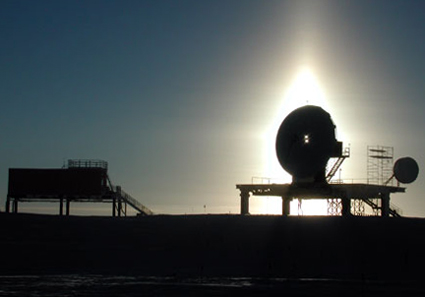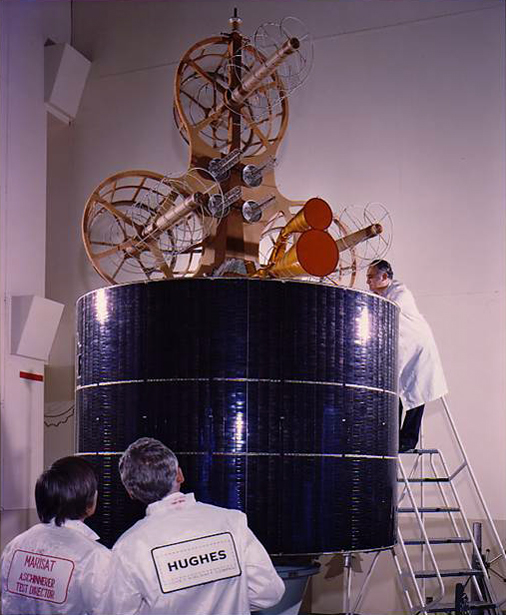|
Outliving expectationsMarisat-F2 satellite held on for 32 years, served South Pole for 8Posted December 12, 2008
Concluding 32 years of distinguished service for global communications, one of three aged communications satellites used to connect South Pole Station Launched on October 14, 1976, Marisat-F2 was one of three Marisat satellites Designed with a five-year lifespan, the satellite originally provided revolutionary new maritime communications for commercial shipping around the world, with a secondary role to support fleet communications for the U.S. Navy. Comsat General inaugurated the modern maritime communications industry with the initial constellation of Marisat satellites, which later evolved into the modern Inmarsat system Intelsat engineers determined that that the satellite’s support sub-systems were finally near the end of operating life. To prevent Marisat-F2 from drifting into the path of other satellites, engineers used its remaining fuel to raise it about 125 miles to disposal altitude, out of the way of other geosynchronous communications satellites and in keeping with modern space debris management practices. The procedure took place two years earlier than originally scheduled because of the risk that engineers might lose control of the satellite. The other two Marisat satellites were retired in the 1990s, but Marisat-F2 continued to operate, and in 2000 was moved from an orbit above the Indian Ocean to one above the Atlantic. Marisat-F2 had always been in “inclined” orbit, meaning it appeared to move a few degrees above and a few degrees below the equator on each trip around the Earth. The original inclination was 3 degrees, and grew to 13 degrees over the satellite’s lifetime as engineers allowed natural forces from the combined gravity effects of the Earth, sun and moon to constantly tug the plane of the orbit. This conserved precious satellite fuel, as satellites do not stay put in geosynchronous orbit. To keep them in place, satellite operators have to fire thrusters in east-west and north-south directions (called “station keeping”). The largest consumption in fuel is north-south, which is the direction that controls the inclination. The strategy is simple: Let a satellite drift north-south (inclination) so you have more fuel to keep it parked longer at a particular longitude (east-west). The inclination growth made it ideal for use by the U.S. Antarctic Program’s The National Science Foundation Rest of the Story
Little known in the annals of Antarctic communications history, but Marisat-F3 provided the first-ever aeronautical satellite communications link to the South Pole when experimental automatic dependent surveillance aeromobile satcom system trials conducted by E-Systems out of Garland, Texas, were flown on-board an NSF LC-130 flown by the U.S. Navy VXE-6 in February 1990. Later, in 1993, a concept test of a telephone link using Marisat-F1 was conducted with the early generation Inmarsat transportable earth station equipment. Still later, in 1994, a telephone link used Marisat-F3 for trials of data transmission in support of astronomy research projects.
Serendipity would have it that the only customer for Marisat-F2 had just announced it would end its contract, leaving Marisat-F2 open for a new customer — or the grave, if none were found. It was a good match, and thanks to the dedicated engineers and managers at Comsat General, who nurtured the Marisat program from concept to its golden years, “The Little Satellite That Could” (as it has been called by the press) was given a new mission and a new lease on life. The satellite was moved over the Atlantic Ocean to provide a direct link back to the United States via a new 9-meter antenna that was built at the South Pole as part of the South Pole Station Modernization program. That program is now in the final stages of a $150 million, decade-long effort to build a modern station. [See article: A new era] Marisat-F2 had been used mainly for Internet services such as phone calls, video conferencing, remote science research instrumentation management, software updates and emergency telemedicine. Marisat-F2 appeared above the horizon two hours earlier than the other two satellites, and when combined with the others, the community at the research station had Internet access for up to 11.5 hours each day. It provided bi-directional 1.544 Mb/s connectivity every day. The remaining two broadband satellites that serve the station are the NASA TDRS F1 The TDRS F1 satellite is now shouldering the burden for primary communications for South Pole Station, as it carries bulk science research data at an amazing volume of 100 gigabytes per day, and recently achieved a record 126 gigabytes per day. It now serves as the primary Internet link. GOES-3 provides primary Internet coverage after TDRS F1 drops out of sight. The remaining 14.5 hours of the day not covered by these broadband satellites are covered by a “thin” Internet link established by combining 12 Iridium satellite data modems. The resulting link is only 28.8 kb/s, half as fast as telephone dial-up modems, but provides essential e-mail and real-time science data feeds. This novel use of Iridium mobile satellite service was the inspiration of NSF and made possible by the hard effort of Raytheon Polar Services Company As NSF looks to the future for modern telecommunications for South Pole Station and its highly successful scientific research program, the search for satellite resources continues. Pat Smith is the manager of Technology Development in the National Science Foundation's Office of Polar Program Antarctic Infrastructure & Logistics |



For USAP Participants |
For The Public |
For Researchers and EducatorsContact UsU.S. National Science FoundationOffice of Polar Programs Geosciences Directorate 2415 Eisenhower Avenue, Suite W7100 Alexandria, VA 22314 Sign up for the NSF Office of Polar Programs newsletter and events. Feedback Form |



